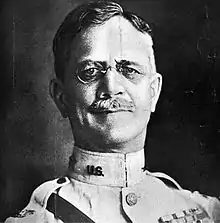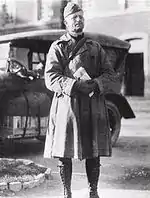Charles Dudley Rhodes | |
|---|---|
 Colonel Charles D. Rhodes, 1922 | |
| Nickname(s) | "Teddy" |
| Born | February 10, 1865 Delaware, Ohio, United States |
| Died | January 24, 1948 (aged 82) Washington, D.C., United States |
| Place of burial | |
| Allegiance | |
| Service/ | |
| Years of service | 1889–1929 |
| Rank | |
| Service number | 0-275 |
| Unit | Cavalry Branch |
| Commands held | Mounted Service School 79th Field Artillery Regiment 157th Artillery Brigade 42nd Division 34th Division |
| Battles/wars | Indian Wars China Relief Expedition Spanish–American War World War I |
| Awards | Distinguished Service Cross Army Distinguished Service Medal Silver Star Order of the Bath Legion of Honor |
| Other work | Author, lecturer |
Charles Dudley Rhodes (February 10, 1865 – January 24, 1948) was a United States Army major general. He was a prominent commander of cavalry units from the Indian Wars through World War I, and was a lecturer and author.
Early life
The son of Major Dudley Woodbridge Rhodes and Marcia Parrish, Charles D. Rhodes was nicknamed "Teddy".[1][2] He was born in Delaware, Ohio, on February 10, 1865, and graduated from Columbian University (now George Washington University) in 1885.[3] In 1889 he graduated from the United States Military Academy, receiving a commission as a second lieutenant of cavalry.[4] Among his fellow graduates included several men who would become general officers, such as William S. Graves, Clement Flagler, Eben Eveleth Winslow, Frank Daniel Webster, Walter Augustus Bethel, Winthrop S. Wood, Chester Harding, William L. Kenly, Joseph D. Leitch, Edward McGlachlin Jr., George LeRoy Irwin, William Wright Harts, William G. Haan, Charles Crawford and William Lassiter. Charles Young was another distinguished graduate, becoming the first African American to attain the rank of colonel.
Early military career
Rhodes served in the 6th Cavalry Regiment during the final US Army campaign against the Sioux.[5]
Rhodes' post-Indian Wars assignments included professor of military science at Ohio Wesleyan University[6] and commander of a cavalry troop during the China Relief Expedition.[7]
Spanish–American War
Rhodes served with the 6th Cavalry Regiment in the Philippines during the Spanish–American War.[8] He received the Distinguished Service Cross for heroism at Cavite on the island of Luzon.[9] The DSC citation reads:
The Distinguished Service Cross is presented to Charles D. Rhodes, Captain, U.S. Army, for extraordinary heroism in action near the barrio of San Nicolas, Pueblo of Bacoor, Cavite, Luzon, Philippine Islands, December 31, 1901. Captain Rhodes gallantly and fearlessly led an attack on a superior body of insurgents with two men of his troop, killing two of the enemy and wounding two, including their leader, and dispersing the remainder.[10]
Post Spanish–American War
Rhodes graduated from the United States Army Command and General Staff College in 1908.[11]
In 1911, Rhodes was an umpire at the mounted exercise conducted by the Massachusetts Volunteer Militia.[12]
Later in 1911, Rhodes and Paul Bernard Malone took part in a confidential mission, traveling to Mexico disguised as journalists to assess the likelihood that Francisco I. Madero could remain in power if he won the presidency in the 1912 election.[13]
During the 1912 Connecticut Maneuvers, Rhodes served as assistant chief of staff for the Red Division.[14]
In 1913 Rhodes was assigned as adjutant of the Cavalry Camp of Instruction at Fort Riley, Kansas, and from 1914 to 1917 Rhodes served as commandant of Fort Riley's Mounted Service School.[15]
World War I

From June to December, after the American entry into World War I, Rhodes commanded the 21st Cavalry Regiment, which was reorganized as the 79th Field Artillery Regiment.[16][17]
During World War I, he commanded the 157th Artillery Brigade, part of the 82nd Division, from February to October 1918, leading the brigade overseas to the Western Front with the rest of the division in May.[18]
Rhodes later assumed command of the 42nd "Rainbow" Infantry Division, receiving temporary promotion to major general. Within days of taking command of the 42nd Division in late 1918, Rhodes was injured in a plane crash, and turned the command over to Brigadier General Douglas MacArthur so he could recuperate.[19][20]
For his services during the war, Rhodes was awarded the Army Distinguished Service Medal and the Silver Star.[21][22] The citation for his Army DSM reads:
The President of the United States of America, authorized by Act of Congress, July 9, 1918, takes pleasure in presenting the Army Distinguished Service Medal to Major General Charles Dudley Rhodes, United States Army, for exceptionally meritorious and distinguished services to the Government of the United States, in a duty of great responsibility during World War I. As Commander of the Artillery Brigade in support of the 82d Division, during the offensive operations of the St. Mihiel salient and again in Command of an Artillery Brigade during the Meuse-Argonne offensive, by his marked ability shown in the conduct of his units General Rhodes contributed in a noted degree to the successes attained. Later he served with distinction as a member of the Inter-Allied Commission at Spa, rendering conspicuous services to the American Expeditionary Forces.[23]
He also received the Order of the Bath from Great Britain and the Legion of Honor from France.[24]
Post World War I
Rhodes graduated from the Army War College in 1920.[25]
His post-World War I assignments included commander of the 34th Infantry Division[26][27] and Chief of Staff of US forces in the Philippines.[28] He was promoted to permanent brigadier general in 1925, and major general in 1928.[29][30]
Career as an author
Rhodes was a writer and lecturer. He authored several books and magazine articles, as well as historical works on cavalry in the Civil War. His works include: History of the Cavalry of the Army of the Potomac (1900); The Vicksburg Campaign (1908); Letters of a West Point Cadet: An Epic in Blank Verse of the Class of 1889, United States Military Academy (1935); Chief Joseph and the Nez Perces Campaign of 1877 (1937); and Diary Notes of a Soldier (1940). Beginning in the 1890s, Rhodes also authored numerous articles and short stories which were published in magazines.
Retirement and death
Rhodes retired from the Army in 1929 and resided in Washington, D.C.[31][32] He died at Walter Reed Hospital on January 24, 1948, and was buried with his wife Mary Counselman (1867–1943) at Arlington National Cemetery.[33]
References
- ↑ Generals in Khaki, by Henry Blaine Davis, 1998, p. 307
- ↑ The Regulars: The American Army, 1898–1941, by Edward M. Coffman, 2007, p. 459
- ↑ General Alumni Catalogue, George Washington University, published by the university, 1930, p. 53
- ↑ The Rhodes Family in America, compiled and published by Nelson Osgood Rhoades, 1919, p. 7
- ↑ The World Almanac & Book of Facts, published by Facts on File, Inc., 1903, p. 405
- ↑ Fifty Years of History of the Ohio Wesleyan University, Delaware, Ohio: 1844–1894, compiled by Professor W.G. Williams, published by Ohio Wesleyan University, 1895, p. 97
- ↑ America in the China Relief Expedition, by Aaron Simon Daggett, 1903, p. 115
- ↑ The Problem in the Philippines, by Henry Moore Teller, 1902, p. 60
- ↑ Home of Heroes Archived 2012-05-14 at the Wayback Machine, Recipients of The Distinguished Service Cross during the Philippine Insurrection, accessed June 30, 2012
- ↑ George Washington Cullum, Edward Singleton Holden, Biographical Register of the Officers and Graduates of the U.S. Military Academy, 1920, pages 523 to 524
- ↑ Annual Report for 1908 published by U.S. Government printing Office, 1908, Volume IV, p. 28
- ↑ Biographical Register of the Officers and Graduates of the United States Military Academy, by George Washington Cullum and Edward Singleton Holden, 1920, Volume 6, Part 1, p. 523
- ↑ The Archaeologist was a Spy: Sylvanus G. Morley and the Office of Naval Intelligence, by Charles Houston Harris III and Louis R. Sadler, 2003, p. 13
- ↑ Biographical Register of the Officers and Graduates of the United States Military Academy, by George Washington Cullum and Edward Singleton Holden, 1920, Volume 6, Part 1, p. 523
- ↑ National Cyclopedia of American Biography, by J.T. White, 1964, Volume 1, p. 433
- ↑ Generals in Khaki, by Henry Blaine Davis, 1998, p. 307
- ↑ National Cyclopedia of American Biography, by J.T. White, 1964, Volume 1, p. 433
- ↑ "Who's Who In Our Army", New York Times, September 8, 1918
- ↑ "Who's Who In Our Army", New York Times, December 1, 1918
- ↑ "Gen. C.D. Rhodes Improved" Archived 2012-11-06 at the Wayback Machine, Baltimore Sun, December 25, 1918
- ↑ Major Military Awards, Charles Dudley Rhodes, Hall of Valor, Military Times, accessed April 25, 2011
- ↑ Record of Hearing before the Committee on U.S. Senate Committee on Military Affairs, on Senate Bill 2328, published by U.S. Senate, March 19, 1940, p. 17
- ↑ "Valor awards for Charles Dudley Rhodes". Military Times.
- ↑ National Cyclopedia of American Biography, by J.T. White, 1964, Volume 1, p. 433
- ↑ Who's Who Among North American Authors, by Golden Syndicate Publishing Company, 1929, Volume 6, p. 867
- ↑ Joseph E. Persico, Eleventh Month, Eleventh Day, Eleventh Hour, 2005, p. 332
- ↑ J.T. White, National Cyclopedia of American Biography, 1964, p. 433
- ↑ Philippines-Japan Relations, by Setsuho Ikehata and Lydia N. Yu-Jose, 2003, p. 54
- ↑ "To Retain Gen. Patrick; War Department Recommends His Reappointment as Air Service Chief", New York Times, July 28, 1935
- ↑ "Two New Major Generals," by Associated Press, published in Syracuse Herald, May 19, 1928
- ↑ Obituary, Charles Dudley Rhodes, Washington Post, January 27, 1948
- ↑ Official U.S. Army Register, published by U.S. Army Adjutant General, 1929, p. 532
- ↑ Burial Detail: Rhodes, Charles D (Section 3, Grave 1486) – ANC Explorer
External links
- Charles Dudley Rhodes at ArlingtonCemetery.net, an unofficial webpage
- Overview of the Charles Dudley Rhodes diary extracts, Hoover Institution, Online Archive of California, accessed April 25, 2011